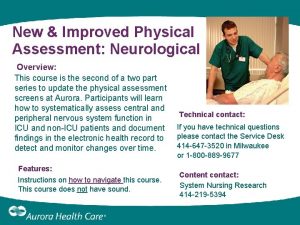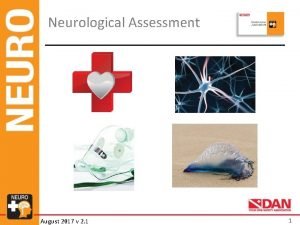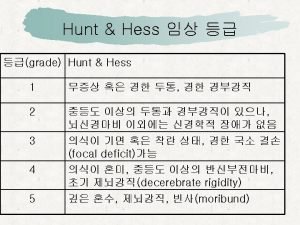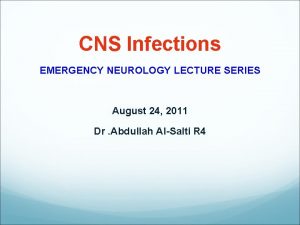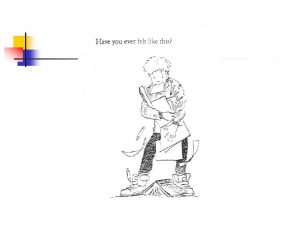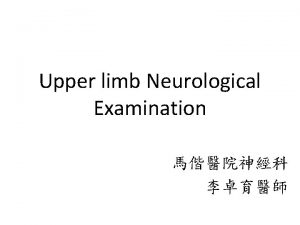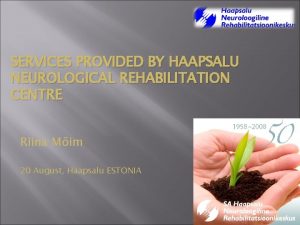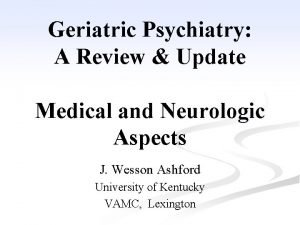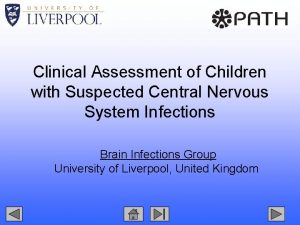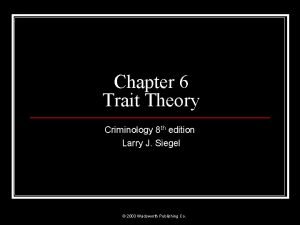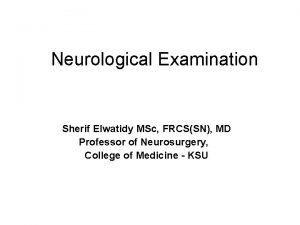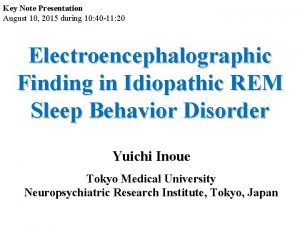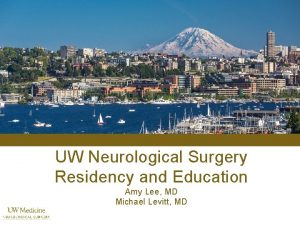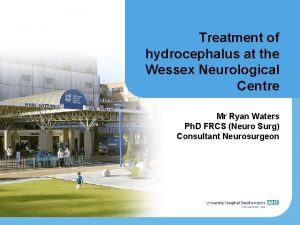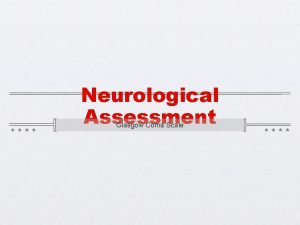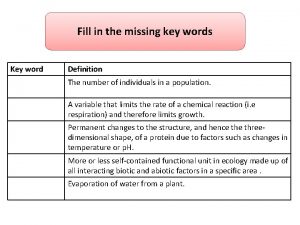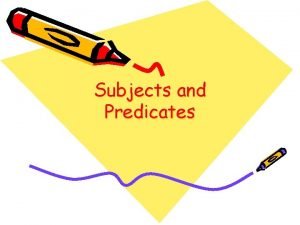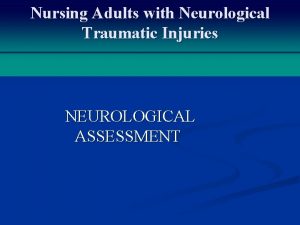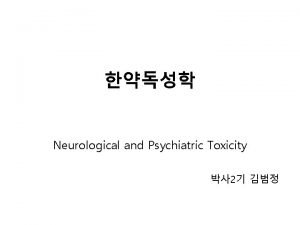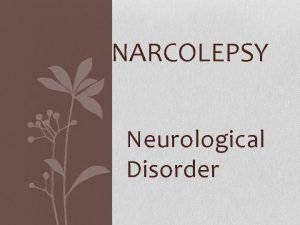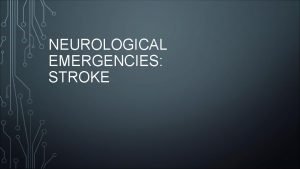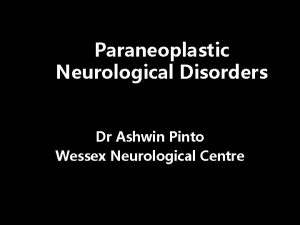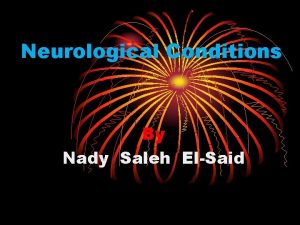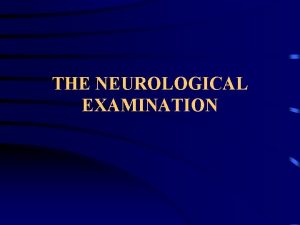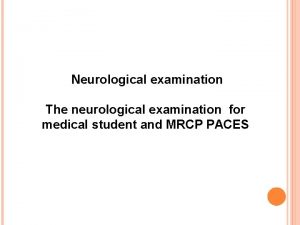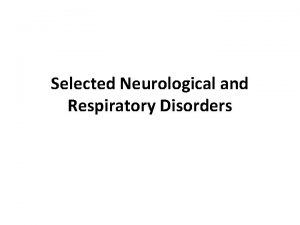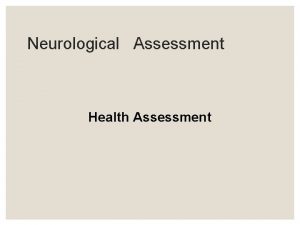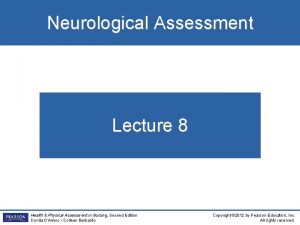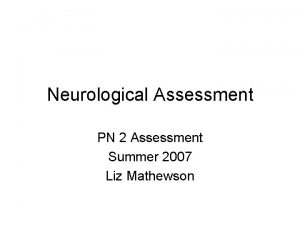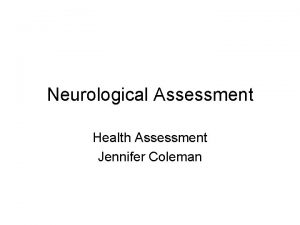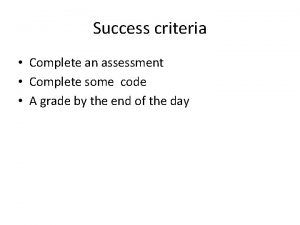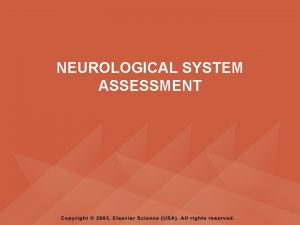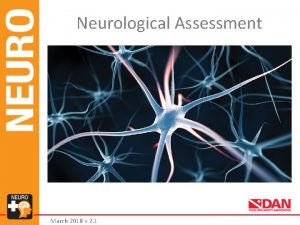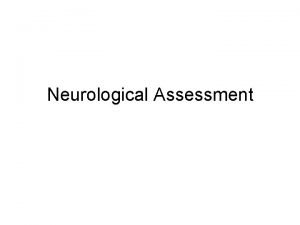Assessment of the NS Neurological Assessment A complete



































- Slides: 35

Assessment of the NS

Neurological Assessment A complete neurological assessment consists of five steps: 1. Mental status exam 2. Cranial nerve assessment 3. Reflex testing 4. Motor system assessment 5. Sensory system assessment

Neurological Assessment As the patient enters the room, check the following: - Gait - Dress, grooming & personal hygiene - Posture & motor behavior. - Facial expression. - Speech manner, mood & relation to persons and things around him

Types of walking gait Waddling gait Spastic gait Stamping Gait Drunken Gait Shuffling gait

Mental assessment Conscious Level Alert: Awake & verbally responsive Lethargic: - Sleepy or drowsy but can be awaken & respond appropriately to command Stupor: - The patient becomes unconscious spontaneously & is very hard to awaken Semi coma: - The patient is not awake but will respond purposefully to deep pain Coma: - The patient is completely unresponsive

Glasgow coma scale (GCS) Grad 6 Grad 5 Grad 4 Obeying command Localizing response to pain. Withdrawal to pain - pulls limb away from painful stimulus. Grad 3 Flexor response to pain - pressure on nail bed causes abnormal flexion of limbs Grad 2 Extensor posturing to pain - stimulus causes limb extension Grad 1 No response to pain.

Assess Grades by Verbal response Grade 5 Grade 4 Grade 3 Grade 2 Grade 1 Oriented - knows who & where they are why he is here, the year, season & month. Confused - patient responds in conversation with some disorientation & confusion. Inappropriate speech - random or exclamatory speech, no conversational exchange. Incomprehensible speech - no words uttered, only moaning. No verbal response.

EYE OPENING Grade 4 Grade 3 Grade 2 Grade 1 Spontaneous eye opening. Eye opening in response to speech - that is, any speech or shout. Eye opening in response to pain. No eye opening.


Cerebellar Functions Ipsilateral body abnor malities due to (double cross). Ø Nystagmus (Disrupt coordination of eye movements). Ø Dysarthria (Scanning speech) Ø Past pointing, Dysmetria, Dysdiadochokinesia. (Disrupt coordination of limb). Ø Ataxia (Impair balance during movement). Ø Intention tremor Ø Hypotonia, but no change in muscle force. Ø Pendulum reflex. Ø No change in sensory thresholds

Cerebellar Disease

Cranial Nerves Evaluating the cranial nerves is an important part of the neurological examination. - Olfactory - Facial - Optic - Vistibulo-cochlear - Oculomotor - Glossopharyngeal - Trochlear - Vagus - Trigeminal - Accessary - Abducens - Hypoglossal




Eye reflexes Corneal reflex Conjunctival reflex Blinking reflex Light reflexes: Accommodation to light. Consensual reflex. Accommodation to distance.

Corneal reflex & Conjunctival reflex Response & Pathway

Blinking reflex

Pupil light reflexes

Normal Pupil 1. Equal

Normal Pupil § React to light (Accommodation to light) Light Dark Exposure to light: Ipsi-lateral Contra-lateral

Small / Unequal pupil No light or consensual reflex There s accommodation to distance



Normal Pupil § React to light (Accommodation to distance).

Normal Pupil § React to light (Accommodation to distance).

Stretch reflex

Monosynaptic reflex Knee Jerk L 2 – L 3 Supinator Jerk C 5 - C 6 Ankle Jerk L 5–S 1 Triceps Jerk C 6 - C 7 Biceps Jerk C 5 - C 6

Superficial reflexes

Ankle Clonus

Equipments for sensory Exam. - Safety pin - Cotton - Tuning fork - Reflex hummer - Flashlight - Ophthalmoscope - Vision screeners - Gloves - Coffee

Sensory function

Sensation and Cerebral Cortex Two Point Discrimination Localization of sensation

Motor function

Involuntary movement
 Neuro wdl
Neuro wdl Motor function neurological assessment
Motor function neurological assessment Abnormal flexion and extension
Abnormal flexion and extension Wfns grading system
Wfns grading system What is focal neurological signs
What is focal neurological signs Is adhd a neurological disorder
Is adhd a neurological disorder Mrc grade
Mrc grade Villa fridheim haapsalu
Villa fridheim haapsalu Neurological based behavior
Neurological based behavior Neurological examination
Neurological examination Muscle power neurological examination
Muscle power neurological examination Neurological exam
Neurological exam Compare and contrast first and second language acquisition
Compare and contrast first and second language acquisition Biochemical theory criminology
Biochemical theory criminology Solent physiotherapy
Solent physiotherapy Neurological examination
Neurological examination Neurological disease
Neurological disease Michael levitt uw
Michael levitt uw Ryan waters neurosurgeon
Ryan waters neurosurgeon Neurological observations glasgow coma scale
Neurological observations glasgow coma scale Bacterial growth
Bacterial growth Whats a complete predicate
Whats a complete predicate Hát kết hợp bộ gõ cơ thể
Hát kết hợp bộ gõ cơ thể Slidetodoc
Slidetodoc Bổ thể
Bổ thể Tỉ lệ cơ thể trẻ em
Tỉ lệ cơ thể trẻ em Gấu đi như thế nào
Gấu đi như thế nào Thang điểm glasgow
Thang điểm glasgow Chúa yêu trần thế
Chúa yêu trần thế Các môn thể thao bắt đầu bằng tiếng chạy
Các môn thể thao bắt đầu bằng tiếng chạy Thế nào là hệ số cao nhất
Thế nào là hệ số cao nhất Các châu lục và đại dương trên thế giới
Các châu lục và đại dương trên thế giới Công thức tính thế năng
Công thức tính thế năng Trời xanh đây là của chúng ta thể thơ
Trời xanh đây là của chúng ta thể thơ Mật thư anh em như thể tay chân
Mật thư anh em như thể tay chân Phép trừ bù
Phép trừ bù
